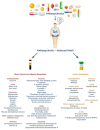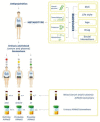Blood and Urinary Biomarkers of Antipsychotic-Induced Metabolic Syndrome
- PMID: 36005598
- PMCID: PMC9416438
- DOI: 10.3390/metabo12080726
Blood and Urinary Biomarkers of Antipsychotic-Induced Metabolic Syndrome
Abstract
Metabolic syndrome (MetS) is a clustering of at least three of the following five medical conditions: abdominal obesity, high blood pressure, high blood sugar, high serum triglycerides, and low serum high-density lipoprotein (HDL). Antipsychotic (AP)-induced MetS (AIMetS) is the most common adverse drug reaction (ADR) of psychiatric pharmacotherapy. Herein, we review the results of studies of blood (serum and plasma) and urinary biomarkers as predictors of AIMetS in patients with schizophrenia (Sch). We reviewed 1440 studies examining 38 blood and 19 urinary metabolic biomarkers, including urinary indicators involved in the development of AIMetS. Among the results, only positive associations were revealed. However, at present, it should be recognized that there is no consensus on the role of any particular urinary biomarker of AIMetS. Evaluation of urinary biomarkers of the development of MetS and AIMetS, as one of the most common concomitant pathological conditions in the treatment of patients with psychiatric disorders, may provide a key to the development of strategies for personalized prevention and treatment of the condition, which is considered a complication of AP therapy for Sch in clinical practice.
Keywords: antipsychotic-induced metabolic syndrome; antipsychotics; metabolic syndrome; personalized metabolomics; personalized psychiatry; serum biomarkers; urinary biomarkers.
Conflict of interest statement
The authors declare no conflict of interest.
Figures



References
-
- Expert Panel on Detection and Evaluation of Treatment of High Blood Cholesterol in Adults Executive summary of the third report of the National Cholesterol Education Program (NCEP) expert panel on detection, evaluation and treatment of high blood cholesterol in adults (Adult Treatment Panel III) JAMA. 2001;285:2486–2497. doi: 10.1001/jama.285.19.2486. - DOI - PubMed
-
- Grundy S.M., Cleeman J.I., Daniels S.R., Donato K.A., Eckel R.H., Franklin B.A., Gordon D.J., Krauss R.M., Savage P.J., Smith S.C., Jr., et al. Diagnosis and management of the metabolic syndrome: An American Heart Association/National Heart, Lung, and Blood Institute Scientific Statement. Circulation. 2005;112:2735–2752. doi: 10.1161/CIRCULATIONAHA.105.169404. - DOI - PubMed
-
- Alberti K.G., Eckel R.H., Grundy S.M., Zimmet P.Z., Cleeman J.I., Donato K.A., Fruchart J.C., James W.P., Loria C.M., Smith S.C. A Joint Interim Statement of the International Diabetes Federation Task Force on Epidemiology and Prevention; National Heart, Lung, and Blood Institute, American Heart Association, World Heart Federation, International Atherosclerosis Society, and International Association for the Study of Obesity. Circulation. 2009;120:1640–1645. - PubMed
-
- Hanley A.J., Karter A.J., Williams K., Festa A., D’Agostino R.B., Jr., Wagenknecht L.E., Haffner S.M. Prediction of type 2 diabetes mellitus with alternative definitions of the metabolic syndrome: The Insulin Resistance Atherosclerosis Study. Circulation. 2005;112:3713–3721. doi: 10.1161/CIRCULATIONAHA.105.559633. - DOI - PubMed
Publication types
LinkOut - more resources
Full Text Sources
Research Materials
Miscellaneous

